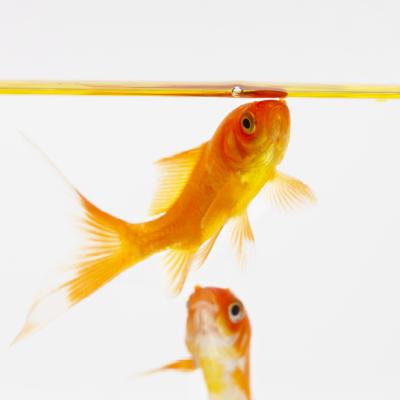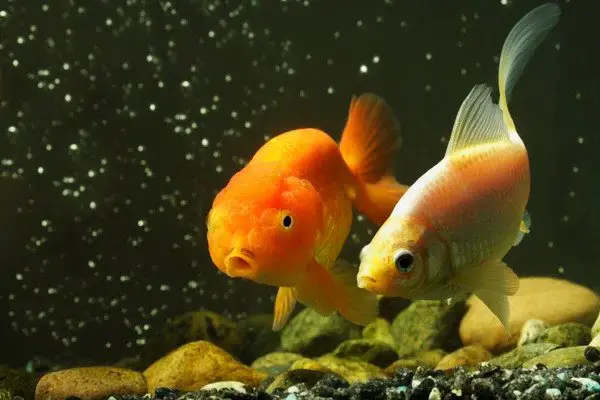Goldfish chase each other due to mating behavior or establishing dominance. Stress or illness can also cause this behavior.
Goldfish are fascinating creatures with various behaviors that often intrigue their owners. One common behavior is chasing each other around the tank. This can be a sign of mating rituals, where males chase females to encourage spawning. Dominance is another reason; goldfish establish social hierarchies by chasing and nudging each other.
Sometimes, stress or illness can also cause this activity, indicating a need to check water conditions or health. Understanding these behaviors helps in ensuring the well-being of your goldfish, providing a happier and healthier environment for them. Proper observation and care are essential for maintaining a peaceful aquarium.
The Social Dynamics Of Goldfish
Goldfish are fascinating creatures with complex social behaviors. Understanding why goldfish chase each other can provide insights into their social dynamics. This behavior often relates to their innate patterns, hierarchy, and dominance.
Innate Behavior Patterns
Goldfish have natural instincts that drive their actions. Chasing can be a display of these innate behavior patterns. They chase each other for various reasons such as mating, play, or establishing social order.
These behaviors are crucial for their survival and well-being. Goldfish use these patterns to communicate and interact with their environment and other fish.
Hierarchy And Dominance
Goldfish live in social groups with a clear hierarchy. Establishing dominance is essential for maintaining order within the group. This often involves chasing and other physical displays.
More dominant goldfish will chase others to assert their position. This ensures that the social structure remains stable and reduces conflicts.
Understanding these dynamics can help in creating a harmonious aquarium environment. Ensuring adequate space and resources can minimize aggressive behaviors.
| Behavior | Reason | Outcome |
|---|---|---|
| Chasing | Mating, Play, Dominance | Establishes Social Order |
| Nipping | Establish Dominance | Hierarchy Established |
| Following | Curiosity, Social Interaction | Builds Social Bonds |
By observing these behaviors, you can better understand your goldfish’s needs. This knowledge helps in providing a better living environment for them.

Credit: animals.mom.com
Mating Rituals: A Common Reason For Pursuit
Goldfish often chase each other for various reasons. One common reason is mating. Understanding their mating rituals helps explain this behavior.
Identifying Mating Behavior
Mating behavior in goldfish is easy to spot. Males usually chase females around the tank. They nudge the females’ bellies to encourage the release of eggs. This act is known as “spawning.”
During this time, males may also display brighter colors. They become more aggressive in their pursuit. Females, on the other hand, may appear stressed or tired. Recognizing these signs helps in identifying mating behavior.
Seasonal Timing Of Goldfish Breeding
Goldfish breeding is seasonal. It usually occurs in spring and summer. Warmer temperatures and longer days trigger this activity. During this period, goldfish become more active.
Table below highlights key breeding season details:
| Season | Temperature Range | Behavioral Changes |
|---|---|---|
| Spring | 65-75°F (18-24°C) | Increased chasing and nudging |
| Summer | 75-80°F (24-27°C) | Peak spawning activity |
Understanding these seasonal patterns helps in predicting goldfish behavior. This knowledge assists in providing optimal care during their breeding season.
Territorial Claims In The Tank
Goldfish often chase each other due to territorial claims in the tank. They want to establish their own space. This behavior can surprise many goldfish owners. Understanding the reasons behind it can help maintain a peaceful tank environment.
Establishing Territory
Goldfish establish their territory to feel safe. They select a favorite spot and defend it. This spot can be a corner or a hiding place. Younger goldfish often challenge the older ones. This can lead to chasing behaviors.
Competition For Resources
Resources in the tank include food, space, and hiding spots. Goldfish compete for these resources. They chase others away to secure more for themselves. This competition is natural among fish.
Here is a table showing common resources and why goldfish compete for them:
| Resource | Reason for Competition |
|---|---|
| Food | Ensures survival and growth |
| Space | Provides comfort and security |
| Hiding Spots | Offers safety from perceived threats |
Stress Responses In Captivity
Goldfish chasing each other can indicate stress. Stress is common in captive goldfish. Understanding why this happens is crucial for their well-being.
Recognizing Signs Of Stress
Goldfish show clear signs of stress. Look for these behaviors:
- Chasing each other relentlessly
- Hiding more than usual
- Rapid breathing or gasping at the surface
- Loss of appetite
- Faded colors
If you notice any of these signs, your goldfish may be stressed. Quick action is needed to relieve their stress.
Impact Of Tank Conditions
Tank conditions greatly affect goldfish stress levels. Here are some important factors to consider:
| Factor | Impact |
|---|---|
| Water Quality | Dirty water stresses goldfish. Regular cleaning is essential. |
| Tank Size | Small tanks cause stress. Ensure adequate space for each fish. |
| Temperature | Incorrect water temperature can stress goldfish. Use a reliable heater. |
| Lighting | Too much or too little light can cause stress. Maintain a natural light cycle. |
| Tank Mates | Incompatible tank mates can cause stress. Choose peaceful companions. |
Maintaining optimal tank conditions helps reduce goldfish stress. Healthy goldfish are happier and more active.
Playfulness Or Aggression?
Goldfish often chase each other in the tank. This can be playful or aggressive. Understanding their behavior helps maintain a peaceful aquarium.
Differentiating Between Play And Conflict
Goldfish play by chasing each other lightly. They swim in circles, but don’t show signs of harm. In contrast, aggressive chasing is more intense and persistent. Aggressive goldfish might nip at fins.
| Behavior | Signs of Play | Signs of Aggression |
|---|---|---|
| Chasing | Light, circular chasing | Intense, persistent chasing |
| Nipping | None | Nipping at fins |
| Body Contact | Gentle, infrequent | Rough, frequent |
Interpreting Body Language
Goldfish body language is key to understanding their behavior. Playful goldfish have relaxed fins. They swim smoothly, without sudden movements. Aggressive goldfish have flared fins. They might dart around quickly.
- Relaxed Fins: Sign of playfulness
- Flaring Fins: Sign of aggression
Goldfish that are playing also swim with ease. They move without sudden jerks. Aggressive goldfish often have fast, jerky movements.
- Observe the fins
- Note the swimming style
- Watch for nipping behavior

Credit: www.quora.com
Health Issues That Influence Behavior
Goldfish chasing each other can be a sign of health problems. Understanding these issues helps keep your fish happy and healthy. Let’s explore some common health issues that can influence goldfish behavior.
Diseases Causing Erratic Movement
Diseases can cause goldfish to move erratically and chase each other. These diseases might include:
- Ich: This disease causes white spots and itching.
- Fin Rot: It makes fins look torn and causes discomfort.
- Swim Bladder Disease: This affects the fish’s ability to swim correctly.
Diseases stress goldfish, leading to unusual behavior. They might chase each other to find relief. Regular health checks can prevent these issues.
Effects Of Poor Water Quality
Poor water quality can make goldfish chase each other. Dirty water leads to stress and health problems. Key factors affecting water quality include:
| Factor | Effect on Goldfish |
|---|---|
| Ammonia Levels | High levels burn their gills. |
| pH Levels | Unbalanced pH causes stress. |
| Temperature | Too hot or cold affects health. |
Keep water clean to prevent these problems. Regular water changes and testing can ensure a safe environment for your goldfish.
The Role Of Diet In Social Interaction
Goldfish often chase each other. This behavior can be linked to their diet. The food they eat influences their actions. Diet affects their social interactions.
Nutritional Deficiencies And Behavior
Goldfish need a balanced diet. A lack of nutrients can cause stress. Stressed fish show odd behaviors. Chasing is one of these behaviors. Ensuring they get the right nutrients is key.
| Nutrient | Effect of Deficiency |
|---|---|
| Protein | Weakness and stress |
| Vitamins | Poor health and chasing behavior |
| Minerals | Increased aggression |
Feeding Practices And Aggression
Feeding practices also impact fish behavior. Overfeeding or underfeeding can cause stress. Overfeeding leads to poor water quality. Poor water quality can stress fish. Underfeeding makes fish compete for food. This competition can lead to chasing.
- Feed small amounts twice a day.
- Ensure food is high quality.
- Avoid overfeeding to keep water clean.
Proper feeding reduces stress. Less stress means less chasing. A balanced diet keeps goldfish happy and calm.
Creating A Harmonious Aquarium Environment
Goldfish chasing each other can be a sign of stress or poor environment. Creating a harmonious aquarium environment helps reduce stress and promote healthy behavior. Ensuring a comfortable and balanced tank is crucial for the well-being of your goldfish.
Tank Size And Setup
Adequate tank size is essential for goldfish. Goldfish need space to swim freely and avoid stress. A minimum of 20 gallons for the first goldfish is recommended. Add 10 gallons for each additional goldfish.
Proper setup includes:
- Adequate filtration system
- Stable water temperature
- Appropriate lighting
- Safe and comfortable hiding spots
Use a soft substrate to protect their delicate fins. Ensure plants and decorations do not have sharp edges. A well-planned setup reduces stress and chasing behavior.
Companion Fish And Community Balance
Goldfish thrive in a balanced community. Choose compatible fish to avoid aggression and stress. Suitable companions include:
- White Cloud Mountain Minnows
- Rosy Barbs
- Weather Loaches
Keep an eye on the community balance. Avoid overcrowding the tank. Overcrowding increases stress and chasing behavior. Maintain a healthy ratio of fish to tank size.
Routine Maintenance For Well-being
Regular maintenance is vital for a healthy aquarium. Perform weekly water changes of 20-30%. Clean the filter monthly to ensure proper filtration. Monitor water parameters to maintain balance.
Check for signs of illness or stress in your goldfish. Remove any sick fish to prevent spreading disease. Provide a varied diet to meet their nutritional needs. Happy and healthy goldfish are less likely to chase each other.

Credit: aquariumlabs.water.blog
Conclusion
Goldfish often chase each other due to mating behaviors, territorial disputes, or health issues. Observing their actions helps understand their needs. Regular tank maintenance and proper care can minimize stress and aggression. Understanding these behaviors ensures a healthier environment for your goldfish, promoting their well-being and happiness.
